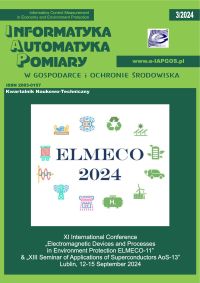SYMULATOR ŹRÓDŁA ELEKTRONÓW Z GORĄCĄ KATODĄ
Abstrakt
W niniejszej pracy opisany został symulator źródła elektronów z gorącą katodą bazujący na modelu statycznym źródła. Został on zaprojektowany w ogólnym przypadku dla różnych rodzajów katod używanych w przyrządach próżniowych w celu umożliwienia łatwych i szybkich modelowych obliczeń numerycznych użytecznych m. in. w procesie projektowania regulatorów natężenia prądu termoemisji elektronowej. Umożliwia on m.in. wyznaczenie rozkładu temperatury i natężenia prądu termoemisji elektronowej włókna w stanie ustalonym.
Słowa kluczowe:
model numeryczny, symulacja, prąd termoemisji elektronowej, próżniaBibliografia
Donkov N., Knapp W.: Control of hot-filament ionization gauge emission current: mathematical model and model-based controller. Measurement Science and Technology 8/1997, 798–803, [DOI: 10.1088/0957-0233/8/7/016].
Google Scholar
Durakiewicz T., Hałas S.: Computation of time-dependent temperature distribution along a filament heated in vacuo by electric pulses. Journal of Vacuum Science & Technology 16/1998, 194, [DOI: 10.1116/1.580968].
Google Scholar
Hałas S., Durakiewicz T.: Temperature distribution along a metal filament heated in vacuum by DC current. Vacuum 49/1998, 331–336, [DOI: 10.1016/S0042-207X(97)00170-X].
Google Scholar
Kmieć A.: Procesy cieplne i aparaty. OWPW, Wrocław 2005.
Google Scholar
Krolopp W., Sikora J., Hałas S.: Simplified dynamic model of electron source with a hot filament. Journal of Technical Physics 1/1997, 87–95.
Google Scholar
Langmuir I.: The effect of end loses on the characteristics of filaments of tungsten and other materials. Physical Review 35/1930, 478, [DOI: 10.1103/PhysRev.35.478].
Google Scholar
Smithells Metals Reference Book, Butterworths, London, 1967.
Google Scholar
Autorzy
Bartosz Kaniab.kania@pollub.pl
Politechnika Lubelska, Katedra Automatyki i Metrologii Polska
Statystyki
Abstract views: 236PDF downloads: 55
Licencja

Utwór dostępny jest na licencji Creative Commons Uznanie autorstwa – Na tych samych warunkach 4.0 Miedzynarodowe.
Inne teksty tego samego autora
- Bartosz Kania, Jarosław Sikora, UKŁADY AUTOMATYCZNEJ REGULACJI PRĄDU TERMOEMISJI ELEKTRONOWEJ W PRÓŻNIOWYCH PRZYRZĄDACH POMIAROWYCH , Informatyka, Automatyka, Pomiary w Gospodarce i Ochronie Środowiska: Tom 4 Nr 3 (2014)
- Bartosz Kania, CYFROWE PODEJŚCIE DO METODY KONWERSJI NATĘŻENIA PRĄDU TERMOEMISJI ELEKTRONOWEJ NA NAPIĘCIE DLA WYSOKONAPIĘCIOWYCH ŹRÓDEŁ ELEKTRONÓW , Informatyka, Automatyka, Pomiary w Gospodarce i Ochronie Środowiska: Tom 12 Nr 4 (2022)








